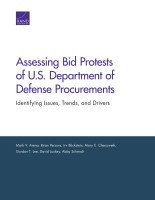| 来源类型 | Research Reports
|
| 规范类型 | 报告
|
| DOI | https://doi.org/10.7249/RR2356
|
| ISBN | 9781977400055
|
| 来源ID | RR-2356-OSD
|
| Assessing Bid Protests of U.S. Department of Defense Procurements: Identifying Issues, Trends, and Drivers |
| Mark V. Arena; Brian Persons; Irv Blickstein; Mary E. Chenoweth; Gordon T. Lee; David Luckey; Abby Schendt
|
| 发表日期 | 2018
|
| 出版年 | 2018
|
| 页码 | 112
|
| 语种 | 英语
|
| 结论 |
Despite a Steady Increase in Bid Protests Filed, Their Numbers Remain Small- Bid protest activity for both DoD and non-DoD agencies roughly doubled between fiscal years 2008 and 2016 at the U.S. Government Accountability Office (GAO) and the U.S. Court of Federal Claims (COFC). DoD agencies accounted for around 60 percent of this activity, with small businesses making up half of these cases.
- The share of contracts protested remains very small — less than 0.3 percent. A significant number of these protests concerned smaller-value contracts ($0.1 million or less).
Trends in Bid Protest Outcomes Differed Between GAO and COFC- Effectiveness rates at GAO — the share of protest cases sustained or in which the contracting agency took corrective action — held steady over time. This suggests that firms are generally not filing protests without merit.
- At GAO, DoD agencies had slightly lower effectiveness rates than non-DoD agencies. Protests of task orders, awards for specific tasks or deliveries under a contract, had slightly higher effectiveness rates than other types of protests.
- The sustained rate at COFC has declined over time, suggesting that firms may be more willing to file protests with the court going forward.
DoD Agencies and the Private Sector Had Differing Views on the Bid Protest Process- DoD personnel were concerned that the process incentivized protests, potentially preventing the timely award of contracts.
- The private sector viewed bid protests as a way to hold the government accountable for providing information about how a decision was made.
|
| 摘要 |
- Enhance the quality of post-award debriefings. Improved debriefings will give disappointed bidders a better understanding of the evaluation and award process and help them better analyze potential protest grounds before filing a protest.
- Be careful in considering reductions to the timeline for resolving bid protests filed with the U.S. Government Accountability Office (GAO) from 100 to 65 days. Seventy percent of protest cases are resolved within 60 days, but complex decisions typically take close to the 100-day limit.
- Be careful in considering restrictions on task-order protests. These protests are more likely to be sustained or involve corrective action, so they may fill an important role in improving the fairness of DoD procurements.
- Consider implementing an expedited process for adjudicating protests involving contracts valued under $0.1 million. The costs to adjudicate these protests under the current system may exceed the value of the procurements.
- Consider approaches to reduce protests by small businesses and improve how they are handled. Changes to the debriefing process should support this effort.
- Consider collecting additional data and making other changes to recordkeeping to facilitate future research and decisionmaking.
|
| 主题 | Military Acquisition and Procurement
; Military Budgets and Defense Spending
; National Defense Authorization Act
; United States Department of Defense
|
| URL | https://www.rand.org/pubs/research_reports/RR2356.html
|
| 来源智库 | RAND Corporation (United States)
|
| 引用统计 |
|
| 资源类型 | 智库出版物
|
| 条目标识符 | http://119.78.100.153/handle/2XGU8XDN/108711
|
推荐引用方式
GB/T 7714 |
Mark V. Arena,Brian Persons,Irv Blickstein,et al. Assessing Bid Protests of U.S. Department of Defense Procurements: Identifying Issues, Trends, and Drivers. 2018.
|
|
文件名:
|
x1515093706924.jpg
|
|
格式:
|
JPEG
|

|
文件名:
|
RAND_RR2356.pdf
|
|
格式:
|
Adobe PDF
|
除非特别说明,本系统中所有内容都受版权保护,并保留所有权利。